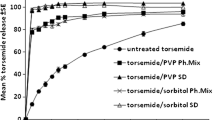Abstract
The objective of this work was to apply response surface approach to investigate main and interaction effects of formulation parameters in optimizing novel fast disintegrating tablet formulation using β cyclodextrin as a diluent. The variables studied were diluent (β cyclodextrin, X 1), superdisintegrant (Croscarmellose sodium, X 2), and direct compression aid (Spray dried lactose, X 3). Tablets were prepared by direct compression method on B2 rotary tablet press using flat plain-face punches and characterized for weight variation, thickness, disintegration time (Y 1), and hardness (Y 2). Disintegration time was strongly affected by quadratic terms of β cyclodextrin, croscarmellose sodium, and spray-dried lactose. The positive value of regression coefficient for β cyclodextrin suggested that hardness increased with increased amount of β cyclodextrin. In general, disintegration of tablets has been reported to slow down with increase in hardness. However in the present study, higher concentration of β cyclodextrin was found to improve tablet hardness without increasing the disintegration time. Thus, β cyclodextrin is proposed as a suitable diluent to achieve fast disintegrating tablets with sufficient hardness. Good correlation between the predicted values and experimental data of the optimized formulation validated prognostic ability of response surface methodology in optimizing fast disintegrating tablets using β cyclodextrin as a diluent.




Similar content being viewed by others
References
Seager H. Drug delivery products and the Zydis fast dissolving dosage. J Pharm Pharmacol. 1998;50:375–82.
Dobetti L. Fast melting tablets: developments and technologies. Pharm Technol Drug Deliv. 2001;44–50.
Fu Y, Yang S, Jeong SH, Kimura K, Park K. Orally fast disintegrating tablets: development, technologies, taste-masking and clinical studies. Crit Rev Ther Drug Carr Syst. 2004;21:433–75.
Wilson CG, Washington N, Peach J, Murray GR, Kennerly J. The behavior of a fast-dissolving dosage form (Expidet) followed by g-scintigraphy. Int J Pharm. 1987;40:119–23.
Bolhuis GK, Armstrong NA. Excipients for direct compression—an update. Pharm Dev Technol. 2006;11:111–24.
Roche-Johnson J, Wang LH, Gordon MS, Chowhan ZT. Effect of formulation solubility and hygroscopicity on disintegrant efficiency in tablets prepared by wet granulation, in terms of dissolution. J Pharm Sci. 1991;80:469–71.
Dobetti L, Fast disintegrating tablets. US Patent 6,596,311 (2003).
Bi Y, Sunada H, Yonezawa Y, Danjo K, Otsuka A, Iida K. Preparation and evaluation of a compressed tablet rapidly disintegrating in the oral cavity. Chem Pharm Bull. 1996;44:2121–7.
Ghorab MM, Abdel-Salem HM, El-Sayed MA, Mekhel MM. Tablet formulation containing meloxicam and β cyclodextrin: mechanical characterization and bioavailability evaluation. AAPS PharmSciTech. 2004;5:E59.
Wade A, Weller PJ. Handbook of pharmaceutical excipients. London: The Pharmaceutical Press; 1994.
Upasani RS, Banga AK. Response surface methodology to investigate the iontophoretic delivery of tacrine hydrochloride. Pharm Res. 2004;21:2293–9.
Branchu SRT, Forbes P, York H, Branchu S, Forbes RT, York P, et al. A central composite design to investigate the thermal stabilization of lysozyme. Pharm Res. 1999;16:702–8.
Budavari S. The merck index. NJ: Merck & Co. Inc.; 1989.
Clarke SE, Austin NE, Bloomer JC, Haddock RE, Higham FC, Hollis FJ, et al. Metabolism and disposition of 14 C-granisetron in rat, dog, and man after intravenous and oral dosing. Xenobiotica. 1994;24:1119–31.
Fu Y, Jeong SH, Park K. Preparation of fast-dissolving tablets based on mannose. C S Symp Ser. 2006;924:340–51.
Khankari R, Hontz J, Chastain S, Katzner L. Rapidly dissolving robust dosage form. US Patent 6,221,392 (2001).
Wehling F, Schuele S, Madamala N. Effervescent dosage forms with microparticles. US Patent 5,178,878 (1993).
Shangraw RF, Pande S, Gala P. Characterization of the tableting properties of β Cyclodextrin and the effects of processing variables on inclusion complex, compactibility and dissolution. Drug Dev Ind Pharm. 1992;18:1831–51.
Rekhi GS, Nellore RV, Hussain AS, Tillman LG, Malinowski HJ, Augsburger LL. Identification of critical formulation and processing variables for metoprolol tartrate extended-release (ER) matrix tablets. J Control Rel. 1999;59:327–42.
Saleh SI. β-Cyclodextrin as a direct compression excipient compared to conventional ones. J Pharm Sci. 1993;48:371–7.
Sunada H, Bi Y. Preparation, evaluation and optimization of rapidly disintegrating tablets. Powder Technol. 2002;122:188–98.
Gissinger D, Stamm A. Comparative evaluation of the properties of some tablet disintegrants. Drug Dev Ind Pharm. 1980;6:419–30.
ElShaboury MH. Physical properties and dissolution profiles of tablets directly compressed with β-cyclodextrin. Int J Pharm. 1990;63:95–100.
Caramella C, Colombo P, Conte U, Ferrari F, la Manna A. Water uptake and disintegration force measurements: towards a general understanding of disintegration mechanism. Drug Dev Ind Pharm. 1986;12:1749–66.
Ferrari F, Bertoni M, Bonferoni MC, Rossi S, Caramella C, Nystrom C. Investigation on bonding and disintegration properties of pharmaceutical materials. Int J Pharm. 1996;136:71–9.
Mattsson S, Bredenberg S, Nystrom C. Formulation of high tensile strength rapidly disintegrating tablets: evaluation of the effect of some binder properties. S T P Pharm Sci. 2001;11:211–20.
Gordon MS, Chowhan ZT. Effect of tablet solubility and hygroscopicity on disintegrant efficiency in direct compression tablets in terms of dissolution. J Pharm Sci. 1987;76:907–9.
Lopes-Solis J, Villafuerte-Robles L. Effect of disintegrants with different hygroscopicity on dissolution of Norfloxacin/Pharmatose DCL 11 tablets. Int J Pharm. 2001;216:127–35.
Chebli C, Cartilier L. Cross-linked cellulose as a tablet excipient: a binding/disintegrating agent. Int J Pharm. 1998;171:101–10.
Acknowledgment
We thank the manufacturers for providing the fast disintegrating tablet samples. The authors also wish to thank Ms. Yi-Ying Yu and Dr. Guohua Li, Mercer University for their help in revising the manuscript and in obtaining stereomicroscopic pictures, respectively.
Author information
Authors and Affiliations
Corresponding author
Rights and permissions
About this article
Cite this article
Late, S.G., Banga, A.K. Response Surface Methodology to Optimize Novel Fast Disintegrating Tablets Using β Cyclodextrin as Diluent. AAPS PharmSciTech 11, 1627–1635 (2010). https://doi.org/10.1208/s12249-010-9541-6
Received:
Accepted:
Published:
Issue Date:
DOI: https://doi.org/10.1208/s12249-010-9541-6




